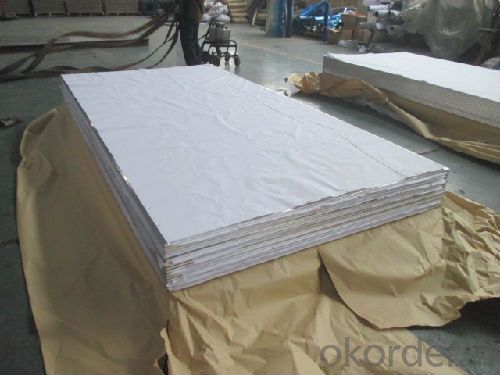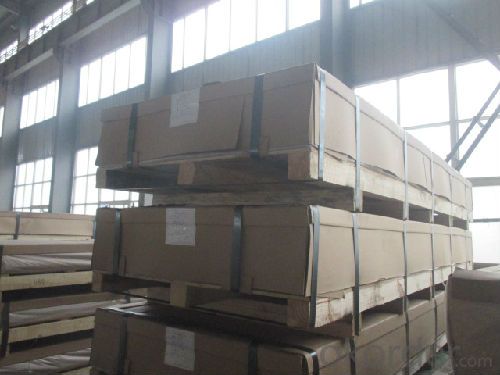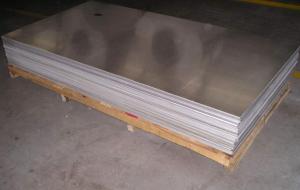Aluminum Sheet And Stainless Steel Sheet Price
- Loading Port:
- Shanghai
- Payment Terms:
- TT or LC
- Min Order Qty:
- 2 m.t.
- Supply Capability:
- 4000 m.t./month
OKorder Service Pledge
OKorder Financial Service
You Might Also Like
1.Structure of Product Description
Cold rolled aluminum sheet and plate and slabs are widely used in the field of construction field and decoration field, etc.
There are many different grades, such as: 1000 series, 2000 series, 3000 series, 5052,5754,5083,6061,6063,8011, etc.
The temper is include H14, H22, H24, H44,O,F, H112,H114,etc.
2. Main features of the product
a. Competitive price
b. Frist-Class Service.
c. Shortest service.
3. Image.


4. Product detailed sizes:
1000mm*2000mm, 1219mm*2440mm, 1250mm*2500mm,1500mm*3000mm, etc.
5. FAQ:
What is the quality standard?
---Usually our standard is GB3880-2006 or others.
What is the width range?
---It is from 1000mm to 2500mm, etc.
---Normally it is around 9000 tons totally.
Where is your client from?
---Normally it is from Japan, USA, ENGLISH, SINGAPORE, ETC.
What is your mainly products?
---Normally they are aluminum sheet, checkered sheet,
big 5 bar and small 5 bar different patttersn, and else,
mirror finish aluminium sheet, aluminum casting coil, etc.
- Q:What are the pricing options for stainless steel sheets?
- The pricing options for stainless steel sheets can vary depending on several factors. The first factor is the grade of stainless steel being used. Stainless steel is available in different grades, with each grade offering different levels of corrosion resistance and durability. Higher-grade stainless steel sheets typically come at a higher price point. Another factor that affects the pricing is the thickness and size of the sheets. Thicker and larger stainless steel sheets tend to be more expensive due to the increased amount of raw material required and the additional processing involved. Furthermore, the finish of the stainless steel sheets can also impact the pricing. Stainless steel sheets can have different finishes such as brushed, mirror, or matte. Finishes that require more extensive processing and polishing may come at a higher cost. Additionally, market conditions, including the supply and demand for stainless steel, can influence the pricing. Prices can fluctuate based on factors like raw material costs, production capacity, and global economic conditions. It is also important to consider the supplier or manufacturer from whom you are purchasing the stainless steel sheets. Different suppliers may offer different pricing options based on their overhead costs, production capabilities, and market positioning. In summary, the pricing options for stainless steel sheets depend on factors such as the grade, thickness, size, finish, market conditions, and the supplier. It is advisable to research and compare prices from different sources to find the most suitable option for your specific requirements.
- Q:What's the thinnest stainless steel plate in China?
- What's the difference between stainless steel and stainless steel?Stainless steel coil, thinnest thickness 0.31mmStainless steel strip, thinnest 0.03mm
- Q:What are the common applications for stainless steel sheets?
- Due to their exceptional properties and durability, stainless steel sheets find a wide range of applications. They are utilized in various industries for different purposes. Some of the common uses include: 1. Architectural purposes: Stainless steel sheets are commonly employed in architectural projects like cladding, roofing, and wall panels. They not only provide a sleek and modern appearance to buildings but also offer corrosion resistance and easy maintenance. 2. Kitchenware manufacturing: Stainless steel sheets are widely used in the production of kitchen appliances, sinks, countertops, and cookware. Their resistance to stains, heat, and corrosion makes them ideal for use in kitchens. 3. Automotive industry: Stainless steel sheets are extensively utilized in the automotive sector for manufacturing exhaust systems, body parts, and trim. They provide strength, corrosion resistance, and an attractive finish, making them suitable for both functional and aesthetic purposes. 4. Medical equipment production: Stainless steel sheets are commonly employed in the manufacturing of medical equipment and instruments. This is due to their hygienic properties, resistance to corrosion, and staining. They are used in surgical instruments, dental tools, hospital equipment, and implants. 5. Chemical and petrochemical industries: The chemical and petrochemical industries extensively use stainless steel sheets due to their resistance to high temperatures, chemicals, and corrosion. They are employed in storage tanks, pipelines, heat exchangers, and other equipment that comes into contact with corrosive substances. 6. Food processing industry: Stainless steel sheets are highly sought after in the food processing industry because of their hygienic properties and resistance to corrosion. They are used to create food preparation surfaces, storage containers, and machinery that must meet strict sanitary standards. 7. Construction projects: Stainless steel sheets are used in construction projects such as bridges, tunnels, and railway tracks due to their strength, durability, and resistance to corrosion. They are also utilized in the construction of industrial buildings, warehouses, and infrastructure. 8. Aerospace industry: Stainless steel sheets find applications in the aerospace industry for various components, including aircraft frames, engine parts, and interior fittings. They offer an excellent strength-to-weight ratio, corrosion resistance, and heat resistance, making them suitable for demanding aerospace applications. In conclusion, stainless steel sheets are a versatile and widely used material in various industries due to their exceptional properties. They are indispensable for many applications.
- Q:What are the different types of stainless steel sheet surface coatings for outdoor applications?
- There are several different types of stainless steel sheet surface coatings that are commonly used for outdoor applications. These coatings are designed to enhance the durability and corrosion resistance of the stainless steel, making it suitable for use in harsh outdoor environments. One of the most common coatings used for outdoor applications is a powder coating. Powder coating is a process in which a dry powder is applied to the stainless steel surface and then cured under heat to form a protective layer. This coating provides excellent resistance to corrosion, UV rays, and chemicals, making it ideal for outdoor use. It also offers a wide range of color options, allowing for customization and aesthetic appeal. Another type of coating commonly used for outdoor applications is a PVD (Physical Vapor Deposition) coating. This process involves the deposition of a thin film of material onto the stainless steel surface through a vacuum chamber. PVD coatings provide excellent adhesion, wear resistance, and corrosion resistance, making them suitable for outdoor applications. They also offer a variety of decorative finishes, such as gold, bronze, or black, which can enhance the appearance of the stainless steel. Additionally, stainless steel can be coated with a ceramic coating for outdoor use. Ceramic coatings are typically applied through a high-temperature spray process, which forms a hard, protective layer on the stainless steel surface. These coatings offer superior resistance to abrasion, chemicals, and UV rays, making them ideal for outdoor applications that require high durability. In summary, the different types of stainless steel sheet surface coatings for outdoor applications include powder coating, PVD coatings, and ceramic coatings. Each of these coatings provides unique benefits in terms of corrosion resistance, durability, and aesthetic appeal, allowing for the use of stainless steel in a wide range of outdoor environments.
- Q:Do stainless steel sheets require any special handling during installation?
- Special handling is necessary when installing stainless steel sheets. Here are some important factors to consider: 1. Prevent Contamination: Stainless steel is easily contaminated by carbon steel, dirt, and grease. It is vital to ensure that the installation area is clean and free from potential contaminants. Additionally, the tools used for installation should be clean and free from other metals. 2. Protect from Scratches: Stainless steel sheets are prone to scratching during installation. It is crucial to handle them carefully and use protective coverings or wraps to prevent any damage. Furthermore, using non-abrasive tools and avoiding dragging or sliding the sheets across surfaces can help maintain their integrity. 3. Use Proper Fixing Techniques: Mechanical fasteners or adhesives are typically used to secure stainless steel sheets. It is essential to follow the manufacturer's recommendations or industry best practices for the specific installation method. This includes using the correct type and size of fasteners and ensuring they are properly tightened without causing damage. 4. Account for Expansion and Contraction: Stainless steel sheets expand or contract with temperature changes. During installation, it is necessary to provide adequate clearance or use expansion joints to accommodate this movement. Failure to consider thermal expansion can result in buckling, warping, or stress on the sheets. 5. Prevent Galvanic Corrosion: Direct contact between stainless steel sheets and dissimilar metals, especially those with higher galvanic potential, can lead to galvanic corrosion. To prevent this type of corrosion, it is important to use compatible materials and insulate stainless steel sheets from direct contact with other metals. By adhering to these special handling guidelines, stainless steel sheets can be installed correctly, ensuring their aesthetic appeal and durability are maintained over time.
- Q:Can stainless steel sheets be used for magnetic shielding?
- Yes, stainless steel sheets can be used for magnetic shielding to some extent. While stainless steel is not inherently magnetic, it does have some magnetic properties. Stainless steel alloys contain iron, a magnetic material, which allows them to exhibit weak magnetic characteristics. However, the magnetic shielding effectiveness of stainless steel sheets is limited compared to other materials specifically designed for magnetic shielding, such as mu-metal or nickel-iron alloys. These materials have a higher permeability, meaning they can redirect and absorb magnetic fields more effectively than stainless steel. Nonetheless, stainless steel sheets can still provide some level of magnetic shielding, especially in lower intensity magnetic fields. They can help reduce the transmission of magnetic fields from one area to another, which might be useful in certain applications. However, for high-intensity or sensitive magnetic shielding requirements, it is recommended to use specialized magnetic shielding materials for optimum effectiveness.
- Q:Are stainless steel sheets suitable for nuclear power plants?
- Yes, stainless steel sheets are suitable for use in nuclear power plants. Stainless steel is a widely used material in the nuclear industry due to its unique properties that make it suitable for such high-risk environments. Firstly, stainless steel has excellent corrosion resistance, which is crucial in nuclear power plants where the presence of corrosive substances can be high. Corrosion can compromise the structural integrity of materials, leading to safety hazards and potential failures. Stainless steel's resistance to corrosion helps ensure the longevity and reliability of equipment and structures in nuclear power plants. Secondly, stainless steel has high strength and toughness, making it capable of withstanding extreme conditions such as high temperatures and pressures that are present in nuclear power plants. This strength and toughness enable stainless steel to withstand the harsh environment and potential mechanical stresses that can occur during normal operation or accidents. Additionally, stainless steel has good heat resistance, which is important in nuclear power plants where high temperatures are generated during the nuclear fission process. Stainless steel's ability to retain its strength and structural integrity even at elevated temperatures makes it suitable for containing and handling radioactive materials and hot fluids. Furthermore, stainless steel is easy to clean and maintain, which is crucial in nuclear power plants where cleanliness and sterility are essential. Regular cleaning and maintenance are required to prevent the build-up of radioactive contaminants and ensure the safe and efficient operation of equipment and systems. Overall, stainless steel sheets are highly suitable for use in nuclear power plants due to their corrosion resistance, strength, toughness, heat resistance, and ease of maintenance. The use of stainless steel helps ensure the safety, reliability, and longevity of equipment and structures, contributing to the overall efficiency and effectiveness of nuclear power plants.
- Q:Do stainless steel sheets require any special handling or storage?
- Special handling and storage are necessary for maintaining the quality and preventing damage of stainless steel sheets. Consider the following essential points: 1. Gloves must be worn while handling stainless steel sheets to prevent leaving fingerprints and oils on the surface, which can cause corrosion. Moreover, sharp tools should be avoided to prevent any surface scratching. 2. To avoid rust or corrosion during storage, stainless steel sheets should be thoroughly cleaned to remove dirt, debris, and moisture. Cleaning can be done using mild soap or a specialized stainless steel cleaner. 3. It is crucial to store stainless steel sheets in a clean, dry, and well-ventilated area. Direct sunlight, extreme temperatures, and moisture should be avoided as they can lead to corrosion. Ideally, the sheets should be stored in a covered area or wrapped in protective materials like plastic or cloth to prevent scratches and damage. 4. Sheets should be separated to prevent contact and potential scratching or damage. This can be achieved by using dividers or interleaf papers between the sheets. 5. When moving or transporting stainless steel sheets, it is advisable to use appropriate handling equipment such as forklifts or cranes. This ensures safe and secure movement without causing any dents or scratches. By adhering to these guidelines for handling and storage, stainless steel sheets can be effectively protected and maintained in optimal condition for their intended use.
- Q:What are the different sheet sizes available for stainless steel?
- Stainless steel sheets come in a variety of sizes to suit different applications and industry requirements. The most common sheet sizes for stainless steel are 4 feet by 8 feet (48 inches by 96 inches) and 4 feet by 10 feet (48 inches by 120 inches). These sizes are widely used in construction, manufacturing, and fabrication industries. However, stainless steel sheets are also available in other sizes depending on the specific needs of the project. Some suppliers offer custom cutting services, allowing customers to order sheets in non-standard dimensions. This flexibility in size options ensures that stainless steel sheets can be tailored to fit various applications, from small-scale projects to large industrial installations. Moreover, the thickness of stainless steel sheets can vary significantly. Standard thicknesses range from 0.4 millimeters to 12 millimeters, but thicker or thinner sheets can be manufactured upon request. Different thicknesses are selected based on the strength and durability required for a particular application. Ultimately, the availability of different sheet sizes for stainless steel ensures that customers have the flexibility to choose the most suitable dimensions for their specific project needs.
- Q:How do I prevent finger marks on stainless steel sheets?
- To prevent finger marks on stainless steel sheets, you can try a few simple steps. Firstly, make sure to clean the sheets regularly using a mild detergent or stainless steel cleaner to remove any existing fingerprints. Next, consider applying a protective coating or film specifically designed for stainless steel surfaces, which can provide a barrier against smudges and fingerprints. Additionally, try to handle the sheets with clean and dry hands to minimize the transfer of oils and dirt. Finally, consider using microfiber or lint-free cloths for cleaning instead of rough materials that can leave scratches or streaks.
1. Manufacturer Overview |
|
|---|---|
| Location | |
| Year Established | |
| Annual Output Value | |
| Main Markets | |
| Company Certifications | |
2. Manufacturer Certificates |
|
|---|---|
| a) Certification Name | |
| Range | |
| Reference | |
| Validity Period | |
3. Manufacturer Capability |
|
|---|---|
| a)Trade Capacity | |
| Nearest Port | |
| Export Percentage | |
| No.of Employees in Trade Department | |
| Language Spoken: | |
| b)Factory Information | |
| Factory Size: | |
| No. of Production Lines | |
| Contract Manufacturing | |
| Product Price Range | |
Send your message to us
Aluminum Sheet And Stainless Steel Sheet Price
- Loading Port:
- Shanghai
- Payment Terms:
- TT or LC
- Min Order Qty:
- 2 m.t.
- Supply Capability:
- 4000 m.t./month
OKorder Service Pledge
OKorder Financial Service
Similar products
New products
Hot products
Hot Searches
Related keywords






























